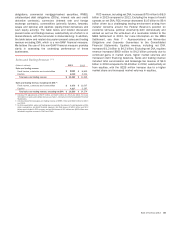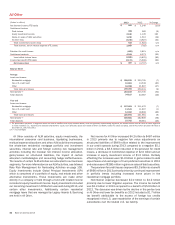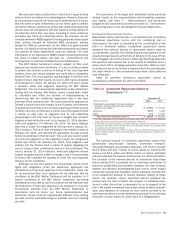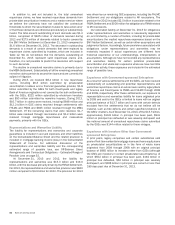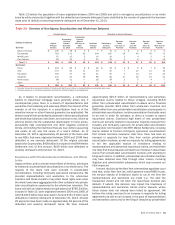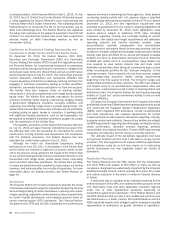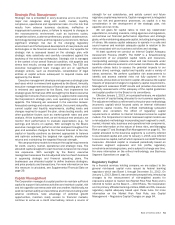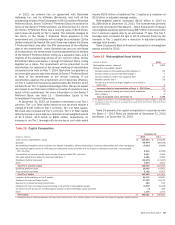Bank of America 2013 Annual Report Download - page 55
Download and view the complete annual report
Please find page 55 of the 2013 Bank of America annual report below. You can navigate through the pages in the report by either clicking on the pages listed below, or by using the keyword search tool below to find specific information within the annual report.Bank of America 2013 53
reasonably estimate the amount of any possible loss with respect
to any such servicing, securities law, fraud or other claims against
us, except to the extent reflected in existing accruals or the
estimated range of possible loss for litigation and regulatory
matters disclosed in Note 12 – Commitments and Contingencies
to the Consolidated Financial Statements; however, in light of the
inherent uncertainties involved in these matters and the very large
or indeterminate damages sought in some of these matters, an
adverse outcome in one or more of these matters could be material
to our results of operations or cash flows for any particular
reporting period.
Future provisions and/or ranges of possible loss for
representations and warranties may be significantly impacted if
actual experiences are different from our assumptions in our
predictive models, including, without limitation, ultimate resolution
of the BNY Mellon Settlement, estimated repurchase rates,
estimated MI rescission rates, economic conditions, estimated
home prices, consumer and counterparty behavior, and a variety
of other judgmental factors.
For more information on the methodology used to estimate the
representations and warranties liability and the corresponding
estimated range of possible loss, see Item 1A. Risk Factors of
this Annual Report on Form 10-K and Note 7 – Representations
and Warranties Obligations and Corporate Guarantees to the
Consolidated Financial Statements and, for more information
related to the sensitivity of the assumptions used to estimate our
liability for obligations under representations and warranties, see
Complex Accounting Estimates – Representations and Warranties
Liability on page 118.
Servicing, Foreclosure and Other Mortgage Matters
We service a large portion of the loans we or our subsidiaries have
securitized and also service loans on behalf of third-party
securitization vehicles and other investors. Our servicing
obligations are set forth in servicing agreements with the
applicable counterparty. These obligations may include, but are
not limited to, loan repurchase requirements in certain
circumstances, indemnifications, payment of fees, advances for
foreclosure costs that are not reimbursable, or responsibility for
losses in excess of partial guarantees for VA loans.
Servicing agreements with the GSEs generally provide the GSEs
with broader rights relative to the servicer than are found in
servicing agreements with private investors. The GSEs claim that
they have the contractual right to demand indemnification or loan
repurchase for certain servicing breaches. In addition, the GSEs’
first-lien mortgage seller/servicer guides provide for timelines to
resolve delinquent loans through workout efforts or liquidation, if
necessary, and purport to require the imposition of compensatory
fees if those deadlines are not satisfied except for reasons beyond
the control of the servicer. In addition, many non-agency RMBS
and whole-loan servicing agreements state that the servicer may
be liable for failure to perform its servicing obligations in keeping
with industry standards or for acts or omissions that involve willful
malfeasance, bad faith or gross negligence in the performance of,
or reckless disregard of, the servicer’s duties.
It is not possible to reasonably estimate our liability with
respect to certain potential servicing-related claims. While we have
recorded certain accruals for servicing-related claims, the amount
of potential liability in excess of existing accruals could be material.
2011 OCC Consent Order and 2013 IFR Acceleration
Agreement
We entered into the 2011 Office of the Comptroller of the Currency
(OCC) Consent Order on April 13, 2011. This consent order
required servicers to make several enhancements to their
servicing operations, including implementation of a single point of
contact model for borrowers throughout the loss mitigation and
foreclosure processes, adoption of measures designed to ensure
that foreclosure activity is halted once a borrower has been
approved for a modification unless the borrower fails to make
payments under the modified loan and implementation of
enhanced controls over third-party vendors that provide default
servicing support services. In addition, the 2011 OCC Consent
Order required that we retain an independent consultant, approved
by the OCC, to conduct a review of all foreclosure actions pending
or foreclosure sales that occurred between January 1, 2009 and
December 31, 2010 and submit a plan to the OCC to remediate
all financial injury to borrowers caused by any deficiencies
identified through the review.
On January 7, 2013, we and other mortgage servicing
institutions entered into an agreement in principle with the OCC
and the Federal Reserve to cease the Independent Foreclosure
Review (IFR) that had commenced pursuant to consent orders
entered into by Bank of America with the Federal Reserve (2011
FRB Consent Order) and the 2011 OCC Consent Order entered
into between BANA and the OCC and replaced it with an accelerated
remediation process (2013 IFR Acceleration Agreement). The
2013 IFR Acceleration Agreement requires us to provide $1.8
billion of borrower assistance in the form of loan modifications
and other foreclosure prevention actions, and in addition, we made
a cash payment of $1.1 billion into a qualified settlement fund in
2013, which was fully reserved at December 31, 2012. The
borrower assistance program is not expected to result in any
incremental credit provision, as we believe that the existing
allowance for credit losses is adequate to absorb any costs that
have not already been recorded as charge-offs.
National Mortgage Settlement
In March 2012, we entered into settlement agreements
(collectively, the National Mortgage Settlement) with (1) the U.S.
Department of Justice, various federal regulatory agencies and 49
state Attorneys General to resolve federal and state investigations
into certain residential mortgage origination, servicing and
foreclosure practices, (2) HUD to resolve certain claims relating
to the origination of FHA-insured mortgage loans, primarily
originated by Countrywide prior to and for a period following our
acquisition of that lender, and (3) each of the Federal Reserve and
the OCC regarding civil monetary penalties related to conduct that
was the subject of consent orders entered into with the banking
regulators in April 2011. The National Mortgage Settlement was
entered by the court as a consent judgment on April 5, 2012. The
National Mortgage Settlement provided for the establishment of
certain uniform servicing standards, upfront cash payments of
approximately $1.9 billion to the state and federal governments
and for borrower restitution, approximately $7.6 billion in borrower
assistance in the form of, among other things, credits earned for
principal reduction, short sales, deeds-in-lieu of foreclosure and
approximately $1.0 billion of credits earned for interest rate
reduction modifications. In addition, the settlement with HUD
provided for an upfront cash payment of $500 million to settle
certain claims related to FHA-insured loans. We will also be




